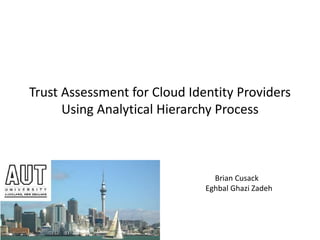Trust assessment 2017 for cloud identity providers using analytical hierarchical process
- 1. Trust Assessment for Cloud Identity Providers Using Analytical Hierarchy Process Brian Cusack Eghbal Ghazi Zadeh
- 2. Objective âą Develop a trust management framework for cloud identity customers that: â Aggregates, manages and measures trust-related information â Attributes, Characteristics, Metrics, Secure elements â From different sources which are available and relevant while assessing the trustworthiness of a cloud identity providers 2
- 3. Cloud Computing 3 âą XaaS (Anything as a Service) âą TaaS (Trust as a Service) âą IDaaS (Identity as a Service)
- 4. Cloud Computing âą Every cloud service has a method of managing identities that may address some of challenges but a user requires to know the trust that may be put in the service. âą The techniques and methods used can be measured by the trust measurement system to help a user to make a good decision 4
- 5. Cloud Identity Management System âą OAuth âą SAML âą Windows CardSpace, Info Card âą Higgins âą U-Prove âą Identity Mixer (Idemix) âą OpenID âą OpenID Connect 5
- 6. OpenID Connect Workflow 6 Auth Server Auth Server Auth Server Auth Server Auth Server Auth Server Cloud Service Provider Cloud Identity Provider Cloud Identity User Trust Framework
- 7. Problem Statement âą Between CIdPs and CIdUs, what are the Essential System Characteristics (ESC) of the published trust establishment methods? âą Prioritizing characteristics and attributes âą Multi-Criteria Decision Making (MCDM) âą Analytical Hierarchy Process (AHP) 7
- 8. Service Trust Evaluation System Architecture 8
- 9. AHP 9 âą AHP approach is one of the more extensively used MCDM methods. âą decomposition, or the hierarchy construction. âą comparative judgments, or defining and executing data collection to obtain pairwise comparison data on elements of the hierarchical structure. âą synthesis of priorities, or constructing an overall priority rating.
- 10. ESC OF CLOUD IDENTITY PROVIDERS âą Balancing âą Single sign-on âą Lifecycle âą Privacy âą Risk âą Standards 10
- 11. Hierarchy of CIdP Decision Making 11
- 12. Weights for Main Characteristics 12
- 13. AHP Result for Standard 13
- 14. Conclusion âą Selecting a trustable and Secure CIdP is essential âą Users require trust information âą Selection of a CIdPs as an MCDM problem âą Critical criteria affecting the decision making âą Theoretical three level AHP model âą 14
- 15. Thank you 15
Editor's Notes
- Cloud entities: This component is responsible for interaction with customers and understanding their application needs. It performs discovery and ranking of services using other components such as trust management, direct/indirect trust, and evaluation methods. Monitoring and history information: This component discovers services that can satisfy user requirements, then it closely monitors the trust performance of the service. The related history records are stored in the service database for access and reference. Computing service network structure and catalogue: This component builds the network structure and the features advertised by the various different providers. The computing resources are divided into different classes to satisfy demand distribution.
- Cloud entities: This component is responsible for interaction with customers and understanding their application needs. It performs discovery and ranking of services using other components such as trust management, direct/indirect trust, and evaluation methods. Monitoring and history information: This component discovers services that can satisfy user requirements, then it closely monitors the trust performance of the service. The related history records are stored in the service database for access and reference. Computing service network structure and catalogue: This component builds the network structure and the features advertised by the various different providers. The computing resources are divided into different classes to satisfy demand distribution.















